2018届高考必考语法精讲之动词时态和语态(word版)复习过程
- 格式:docx
- 大小:55.07 KB
- 文档页数:15
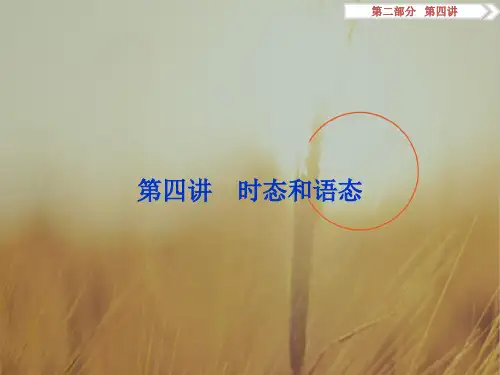
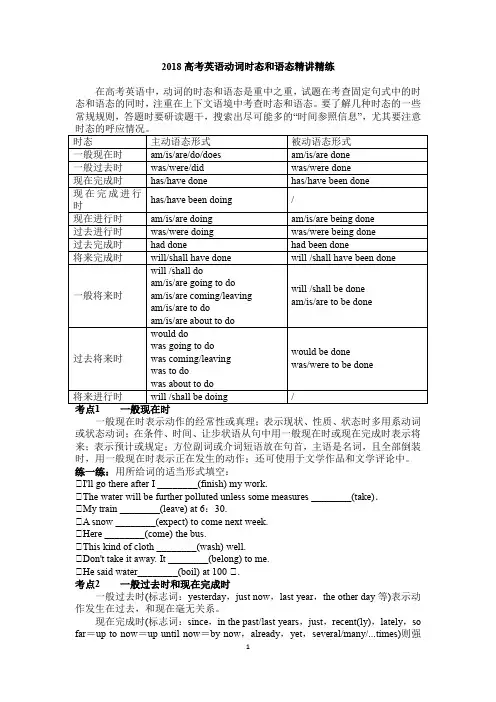
2018高考英语动词时态和语态精讲精练在高考英语中,动词的时态和语态是重中之重,试题在考查固定句式中的时态和语态的同时,注重在上下文语境中考查时态和语态。
要了解几种时态的一些常规规则,答题时要研读题干,搜索出尽可能多的“时间参照信息”,尤其要注意一般现在时表示动作的经常性或真理;表示现状、性质、状态时多用系动词或状态动词;在条件、时间、让步状语从句中用一般现在时或现在完成时表示将来;表示预计或规定;方位副词或介词短语放在句首,主语是名词,且全部倒装时,用一般现在时表示正在发生的动作;还可使用于文学作品和文学评论中。
练一练:用所给词的适当形式填空:①I'll go there after I ________(finish) my work.②The water will be further polluted unless some measures ________(take).③My train ________(leave) at 6:30.④A snow ________(expect) to come next week.⑤Here ________(come) the bus.⑥This kind of cloth ________(wash) well.⑦Don't take it away. It ________(belong) to me.⑧He said water________(boil) at 100 ℃.考点2一般过去时和现在完成时一般过去时(标志词:yesterday,just now,last year,the other day等)表示动作发生在过去,和现在毫无关系。
现在完成时(标志词:since,in the past/last years,just,recent(ly),lately,so far=up to now=up until now=by now,already,yet,several/many/...times)则强调的是对现在的影响和结果,动作到现在刚完成或还在继续。


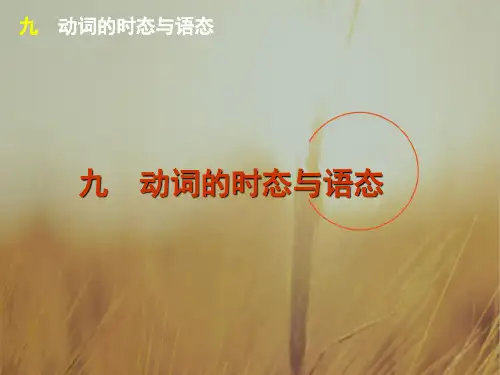
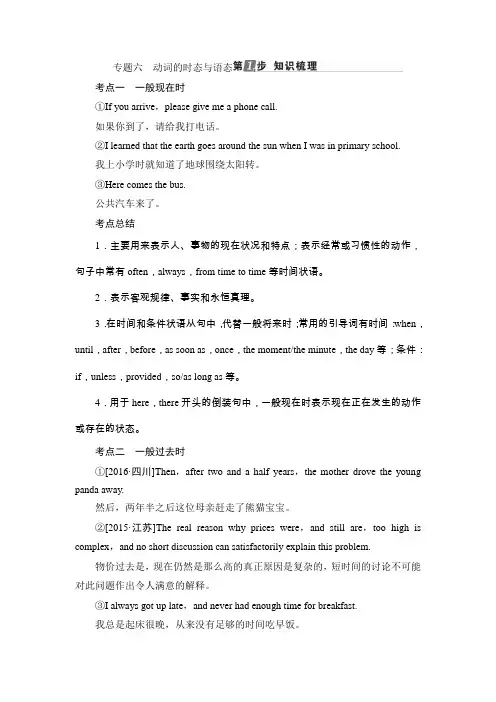
专题六动词的时态与语态考点一一般现在时①If you arrive,please give me a phone call.如果你到了,请给我打电话。
②I learned that the earth goes around the sun when I was in primary school.我上小学时就知道了地球围绕太阳转。
③Here comes the bus.公共汽车来了。
考点总结1.主要用来表示人、事物的现在状况和特点;表示经常或习惯性的动作,句子中常有often,always,from time to time等时间状语。
2.表示客观规律、事实和永恒真理。
3.在时间和条件状语从句中,代替一般将来时;常用的引导词有时间:when,until,after,before,as soon as,once,the moment/the minute,the day等;条件:if,unless,provided,so/as long as等。
4.用于here,there开头的倒装句中,一般现在时表示现在正在发生的动作或存在的状态。
考点二一般过去时①[2016·四川]Then,after two and a half years,the mother drove the young panda away.然后,两年半之后这位母亲赶走了熊猫宝宝。
②[2015·江苏]The real reason why prices were,and still are,too high is complex,and no short discussion can satisfactorily explain this problem.物价过去是,现在仍然是那么高的真正原因是复杂的,短时间的讨论不可能对此问题作出令人满意的解释。
③I always got up late,and never had enough time for breakfast.我总是起床很晚,从来没有足够的时间吃早饭。
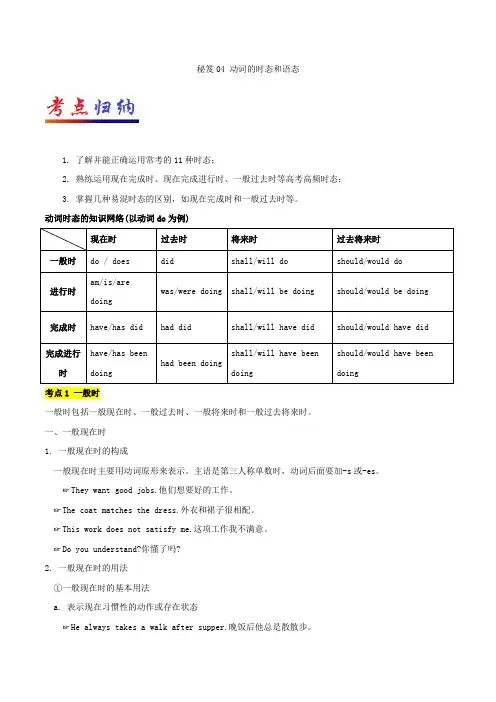
秘笈04 动词的时态和语态1. 了解并能正确运用常考的11种时态;2. 熟练运用现在完成时、现在完成进行时、一般过去时等高考高频时态;3. 掌握几种易混时态的区别,如现在完成时和一般过去时等。
动词时态的知识网络(以动词do为例)一般时包括一般现在时、一般过去时、一般将来时和一般过去将来时。
一、一般现在时1. 一般现在时的构成一般现在时主要用动词原形来表示。
主语是第三人称单数时,动词后面要加-s或-es。
☞They want good jobs.他们想要好的工作。
☞The coat matches the dress.外衣和裙子很相配。
☞This work does not satisfy me.这项工作我不满意。
☞Do you understand?你懂了吗?2. 一般现在时的用法①一般现在时的基本用法a. 表示现在习惯性的动作或存在状态☞He always takes a walk after supper.晚饭后他总是散散步。
☞Everyone is in high spirits now.现在大家都情绪高涨。
b. 表示客观事实或普遍真理☞The sun rises in the east and sets in the west.太阳从东方升起在西方落下。
☞Sound travels faster through water than it does through air.声音在水中的传播速度要比在空气中快。
☞Time and tide wait for no man.时间不等人。
c. 表示主语的特征、能力和状态☞This cloth feels soft.这布摸上去很软。
☞I love classical music.我喜欢古典音乐。
☞The President still seems able to find time to go fishing.看来总统仍能有时间去钓鱼。
d. 表示按计划或安排将要发生的动作☞The meeting begins at 7:00.会议七点钟开始。
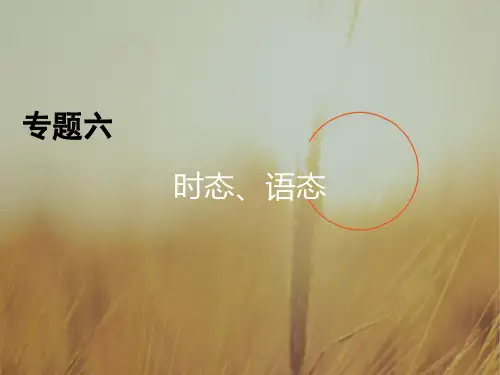
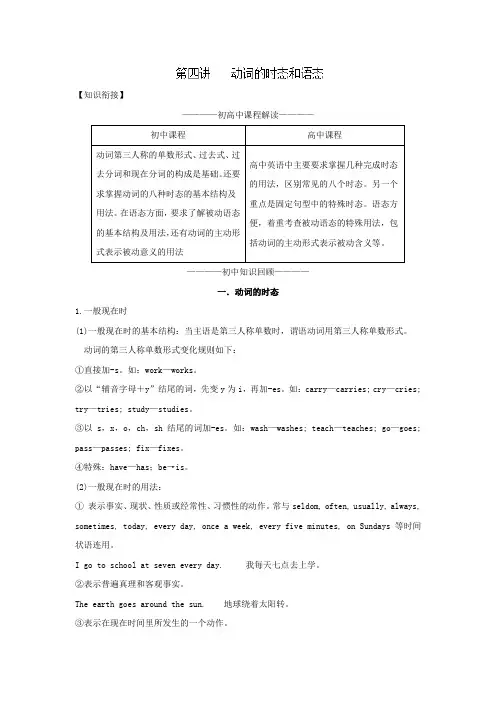
【知识衔接】————初高中课程解读————————初中知识回顾————一.动词的时态1.一般现在时(1)一般现在时的基本结构:当主语是第三人称单数时,谓语动词用第三人称单数形式。
动词的第三人称单数形式变化规则如下:①直接加-s。
如:work—works。
②以“辅音字母+y”结尾的词,先变y为i,再加-es。
如:carry—carries; cry—cries; try—tries; study—studies。
③以s,x,o,ch,sh结尾的词加-es。
如:wash—washes; teach—teaches; go—goes; pass—passes; fix—fixes。
④特殊:have—has;be→is。
(2)一般现在时的用法:①表示事实、现状、性质或经常性、习惯性的动作。
常与seldom, often, usually, always, sometimes, today, every day, once a week, every five minutes, on Sundays等时间状语连用。
I go to school at seven every day. 我每天七点去上学。
②表示普遍真理和客观事实。
The earth goes around the sun. 地球绕着太阳转。
③表示在现在时间里所发生的一个动作。
Here comes the bus. 公共汽车来了。
④在时间和条件状语从句中代替一般将来时。
I'll go shopping with my mother if she is free tomorrow.如果明天我妈妈有空的话,我将和她去购物。
(3) 一般现在时的疑问句、否定句Do you see the bird in the tree? 你看见树上的鸟了吗?2.一般过去时(1)一般过去时的用法及标志词一般过去时表示过去发生的动作或存在的状态。
句中的谓语动词要变为过去式。
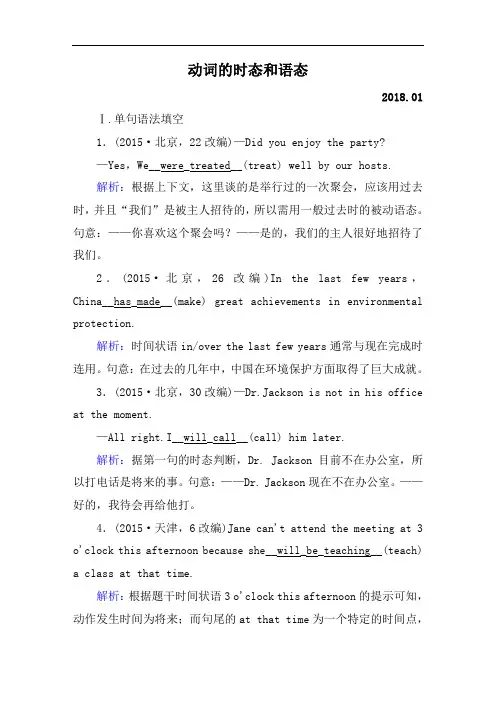
动词的时态和语态2018.01 Ⅰ.单句语法填空1.(2015·北京,22改编)—Did you enjoy the party?—Yes,We__were_treated__(treat) well by our hosts.解析:根据上下文,这里谈的是举行过的一次聚会,应该用过去时,并且“我们”是被主人招待的,所以需用一般过去时的被动语态。
句意:——你喜欢这个聚会吗?——是的,我们的主人很好地招待了我们。
2.(2015·北京,26改编)In the last few years,China__has_made__(make) great achievements in environmental protection.解析:时间状语in/over the last few years通常与现在完成时连用。
句意:在过去的几年中,中国在环境保护方面取得了巨大成就。
3.(2015·北京,30改编)—Dr.Jackson is not in his office at the moment.—All right.I__will_call__(call) him later.解析:据第一句的时态判断,Dr. Jackson目前不在办公室,所以打电话是将来的事。
句意:——Dr. Jackson现在不在办公室。
——好的,我待会再给他打。
4.(2015·天津,6改编)Jane can't attend the meeting at 3 o'clock this afternoon because she__will_be_teaching__(teach) a class at that time.解析:根据题干时间状语3 o'clock this afternoon的提示可知,动作发生时间为将来;而句尾的at that time为一个特定的时间点,因此,该题强调在将来的大时间背景下的某一个特定时间点发生的事,故用将来进行时。

专题07 动词的时态与语态动词的时态、语态和语气是高考中的重中之重,也是英语句子结构的核心。
英语句子的灵动性很大程度上体现在动词的各种变化上,因此谓语动词的时态、语态、语气的运用三位一体,不可分割。
在单项填空题型中,时态和语态是考查的热点,但是语气问题也不可忽视。
在备考过程中应该对谓语动词变化的各种情况都能够了如指掌。
可以预测,未来高考仍然会以考查时态为主,但考查形式会更多地结合语态和语气等形式,越来越侧重在语境中考查动词的时态、语态和语气,所以要求考生首先要掌握时态、语态和语气的基本用法,同时在所设置的语境中根据所给信息进行判断。
也就是说,考生应学会通过上下文来确定所用时态、语态和语气。
热点题型一一般时态例1、The real reason why prices ________,and still are,too high is complex,and no short discussion can satisfactorily explain this problem.A.were B.will beC.have been D.had been答案:A【提分秘籍】1.一般现在时(1)表示经常发生的、习惯性的、反复出现的动作或状态。
常与表示习惯的副词(词组)always,every time,now and then,occasionally,often,seldom,sometimes,usually,every day/night等连用。
(2)按时间表、时刻表、日程表等安排将要发生的动作,用一般现在时。
只限于go,arrive,leave,start,stay,return,begin,come等动词。
(3)用在时间、条件或让步状语从句中,用一般现在时表示将来。
Around two o’clock every night,Sue will start talking in her dream.It somewhat bothers us.每天晚上两点左右,苏就说梦话。
时态语态及一般用法谓语组成时间状语特别用法一般此刻时:Be (am, is, are) do always,usually,ev 1) 按火车、汽车、飞机等时辰1) 常常性或习惯性的动作/ does ery time,seldom, 表将要发生的事2) 此刻的特点,状态及能am / is / are done sometimes often, 2) 在时间、条件、方式状语从力now 句中,用一般此刻时取代一3) 广泛真谛 , 格言警语and then, 般未来时。
occasionally 特别句型 :1)Here/Therecomes ourteacher.( 一般此刻时表正发生动作 )2)It is/has been+ 时段+since .一般过去时:be (was, were) yesterday, last表示过去发生的,和此刻did week, an hour无联系的动作或状态或ago, the other习惯动作was/were done day, in 1982, justnow一般未来时:will/shall do next , tomorrow, 1 )一般未来时可用来表示一未来某个时辰(或某段时am/is/are going in+ 时段, from 种偏向或习惯性动作 .间内)未来要发生的动作to do now on, in the eg. Oil will float on water.am/is/are to do future, Whenever he has time, heam/is/ are about to dowill/shall be done would/should be donewas/were going to be done will come.其否认式表示“ 不可以没法”The machine won’ t work.( 机器无法开动)2 )Cf:be going to表示说话前已经作出的主观的打算或计划,或用来表达有某种迹象要发生的事will do 表示讲话时暂时决定的企图,拥有暂时性和有时性be to do 表示商定、计划或职责、义务要求马上发生的动作。
专题四动词的时态、语态和语气动词的时态、语态和语气是高考中的重中之重,在备考过程中应该对谓语动词变化的各种情况了如指掌。
动词的时态变化如下:(以do为例)考点1一般时态1.一般现在时(1)表示现在的习惯性、经常性发生的动作或存在的状态,常与表示频度的时间状语连用,如usually,often,always,sometimes,every day等。
On Monday morning it usually takes me an hour to drive to work.周一早晨我往往需要开车一小时去上班。
(2)表示客观事实、真理、格言或者警句等。
(3)表示按照时间表、计划安排好的或者规定的行为,只限于go,come,leave,start,stop,arrive 等表示动作趋向性或移动意义的词。
The train leaves at six tomorrow morning.这列火车明早六点出发。
(4)在时间、条件状语从句中常用一般现在时代替一般将来时。
If it doesn't rain,we'll go on a picnic as planned.如果不下雨,我们将按计划去野餐。
2.一般过去时(1)表示过去某个时间发生的动作或存在的状态,常用yesterday,last year,in 1995,the other day 等作时间状语。
(2015·湖北高考)Three weeks ago,I witnessed a small near-disaster a few miles west of here.三周前,我在从这里以西几英里的地方目睹了一起小事故。
(2)表达“原以为/本来认为/原希望”等意义时,know,think,expect等动词常用一般过去时。
(2015·重庆高考)I didn't expect anything when I handed in my paper to Mrs.Smith,so it was quite a surprise when it came back to me the next day-with an “A”on it.我把论文交给史密斯先生的时候并没有期望什么,因此当第二天论文被评为A回到我手中时,我吃了一惊。
高考常考动词时态语态考点透析知清1. 熟知九种基本的组成;2.九种基本的用法及要点;3.一般去与在用法上的要点;4. 被的基本形式;5.被中特别状况;6.与有关的固定句式构。
学情剖析考生在和的学程中存在着以下几点:1.考生于的基本型不可以熟掌握;2. 不的去式及去分形式不清楚;3.句子中的主被意淡;4. 被的基本形式 . 不可以正确使用被;5.在使用 . 全凭所的感去判断 . 写出来的句子中杂乱 . 没有念 . 没有章法可言。
的基本构及用法( 以 do 例 )一般一般构被构常用状意(be done)1.常性或性作;2. 表示在的特征.一般do/does____________always,. 好 . 状等;在am/is/are done usually, often, 3.表示客真谛、科学事sometimes、格言。
did yesterday,表示去生的作或存一般was/were____________last⋯, just在的状。
去done now, in thepast, ⋯agotomorrow, next表示未来可能会出的一般将will____________week, soon, in+作或状。
来do/be done段行 ((be doing)一般构被构常用状意(be done)1.在正在生的作;2.段正在行的作在am/is/are am/is/are ______now, right或表示期或重复的行doing done now, at the作;moment 3.在行表示未来.按划或安排要生的作。
at this time表示去某一或某一去_________________ _______yesterday, at段内正在行的作。
doing done the moment,whenat this time表示未来某一正在未来________无tomorrow; in行的作。
doing two days, soon达成 (have done)一般构被构常用状意(be done)在has/have has/have yet, already, 1.表示一个作生在done________done for, since,去.已达成.且在recently, ever,造成影响或果;just, still. so 2.表示一个作从去持far到在. 且可能持下去。
2018届高考必考语法精讲之动词时态和语态(w o r d版)精品文档2018 届高考必考语法精讲:动词的时态和语态语法中的时态(tense)是一种动词形式,同一动词的不同变化形式表达不同的时态,英语中有16 种时态。
《2017年普通高等学校招生全国统一考试大纲》附录语法项目表中对于时态列了十项:(1)一般现在时(2)一般过去时(3)一般将来时(4)现在进行时(5)过去进行时(6)过去将来时(7)将来进行时(8)现在完成时(9)过去完成时(10)现在完成进行时;此外还列了被动语态,并将其作为单独一项。
2015 年高考全国卷Ⅰ第61 题(语法填空)考查了动词arrive 的一般过去时arrived;第71 题(短文改错)考查了think 变为过去时thought;第75 题(短文改错)考查了被动语态,删掉been;第79 题(短文改错)考查了将动词过去时的found 变为现在时的find。
2016 年高考全国卷Ⅰ第62 题(语法填空)考查了allow 的一般过去时的被动语态was allowed;第74 题(短文改错)考查了将过去时had 变为现在时的have;77 题(短文改错)考查了将using 变为被动used。
2017 年高考全国卷Ⅰ第64 题(语法填空)考查了remove 的一般现在时的被动语态are removed;第74 题(短文改错)考查了将动词goes 变成一般过去时went。
各种时态构成表:(以do 为例)一般时态进行时态完成时态完成进行时态现在do/does is/am/are doing has/have done has/have been doing过去did was /were doing had done had been doing将来shall/will do shall/will be doing shall/will have done shall/will have been doing过去将来would do would be doing would have done would have been doing一、一般现在时:动词原形或第三人称单数1.构成:使用动词原形,第三人称单数须有变化。
(1)直接加“s”:work→works,take→takes(2)以辅音加“y”结尾,变“y”为“i”,再加“es”:carry→carries(3)以“o, s, x, ch, sh”结尾的动词加“es”:go→goes,dress→dresses,watch→watches,finish→finishes2.功能:(1)表现在的事实、状态或动作。
例如:①I have a dream.②She loves music.③Mary's parents get up very early.(2)表习惯性动作或职业,常与often,sometimes,usually,always,every week,occasionally,frequently,seldom 等时间副词连用。
例如:精品文档①I always take a walk after supper.②She writes to me very often.③She is an English teacher.(3)表客观真理,格言警句或事实。
例如:①The earth moves around the sun.②The sun rises in the east and sets in the west.③Two and two makes four.④No man but errs.(4)表示将来发生的动作:A.在由when,after, before,as,as soon as,although,because,if,even if,in case,till,until,unless,as long as,where,whatever,wherever 等引导的状语从句中用一般现在时表将来发生的动作。
例如:①I'll tell her when she comes tomorrow.②Even if it rains this afternoon, I'll meet you.③Whatever happens, you should keep cool-headed.④I'll be right here waiting for you wherever you go.B.按时间表将要发生的动作或事件,用一般现在时表达将来时概念。
例如:①The play begins at 6:30 this evening.②When does the plane take off?③He leaves for that city next week.④According to the timetable, the train starts at 9 o’clock.二.一般过去时:动词的过去式1.表示过去某个特定时间或某一段时间发生的动作或情况。
例如:①We visited the school last spring.②I went to school by bike when I was in middle school.③China was founded in 1949.2.在表示时间或条件等的状语从句中代替过去将来时。
例如:①She told me she would’t go with us if it rained the next day.②They would not leave until she came back.③His girlfriend promised to marry him once he bought her a big house.三.一般将来时:shall / will + 动词原形1.表示将要发生的动作或存在的状态。
例如:①He will graduate from the college next year.精品文档②We shall finish our work as quickly as possible.2.将来时的其它结构。
例如:I .is/am/are going to do sth.(美国口语中常读作be gonna)①I'm going to buy a new car this fall.②He is going to sell his house.注意:be going to 与will 的对比:下列情况须用will①I will be sixteen years old next year.②It will be the 20th of August tomorrow.③When he comes, I will give him your message.II. is/am/are + to do sth.表示计划安排做某事或征求意见。
例如:①Am I to take over his work?②We are to meet at the gate.III. is/am/are about to do sth. 即将做某事。
例如:①The talk is about to begin.四.一般过去将来时:would + 动词原形1.表示过去某时之后将出现的情况,通常用于宾语从句中。
例如:①He said that they would meet me at the station.②She told me that she would come to see me.2.表示过去习惯性动作(不管什么人称都用would)。
例如:①Whenever he had time,Tom would go to see his grandma.②The old couple would go for a walk after supper.注意句型:was/were about to do sth. when……正要做某事,这时……=was/were on the point of doing sth. when……(when 引导的从句要用一般过去时)例如:①He was about to go out when the telephone rang.②I was about to go shopping when it rained.③She was on the point of having supper when the light went off.五.现在进行时:is / am / are +现在分词1.表示现在正在进行的动作。
例如:①The water is boiling. Shall I make tea?②The workers are building a new bridge across the river.2.表现阶段正进行的动作。
例如:①He is taking physics this semester.②We are preparing for our final examination this week.③Don't you think you eat too much? You're putting on weight.3.go, come, leave, arrive, land, meet, die, start, return, join, etc.用于进行时态时表示即将开始的动作。
例如:①Look! The bus is coming.②The old man is seriously ill, and he is dying.③Alice is leaving for Shanghai with her mother.4.与always, forever, continually, constantly 等副词连用,表示说话人带有感情色彩:赞赏或厌恶。
例如:①He is always thinking of others.②The boy is continually making noises.③The teacher is constantly criticizing her for being late.六.过去进行时:was /were +现在分词1.表示过去某一时刻或阶段正在发生的动作。
例如:①I was playing chess at 8 yesterday evening.②When I arrived, they were watching TV.③They were doing housework this time last week.2.用于条件状语从句中表示过去将来进行的动作。